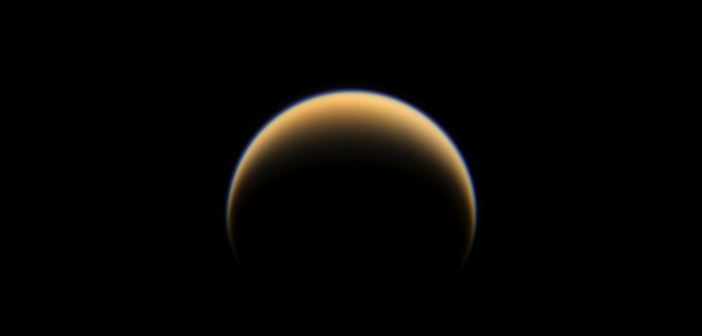Astronomers have detected dozens of molecules in the hazy atmosphere of Saturn’s moon Titan, but they’re still figuring out how these molecules formed. What can radio observations tell us about where Titan’s molecules came from?
A Trio of Molecular Forms

A model of a cyanoacetylene molecule. [Ben Mills and Wikipedia user Jynto]
Swapping a carbon-12 atom (the most common isotope of carbon) for a more massive carbon-13 atom has a subtle but measurable effect on the molecule’s spectrum. Spectra of isotopologues — molecules containing one or more isotopes — can be used to calculate the abundance of each form of the molecule and understand how that molecule forms. For example, if a molecule containing a carbon-13 atom reacts to create a larger molecule, it passes the atom to the newly formed molecule. The location of the carbon-13 atom within the new molecule gives us a hint as to what smaller molecules it was made from, so measuring which form of cyanoacetylene is most common can tell us how it tends to be made.
Molecules Detected in Millimeter Waves
Cyanoacetylene was discovered in Titan’s atmosphere during the Voyager 1 flyby in 1979, but its isotopologues were detected decades later. Luckily, we now have many observations of these molecules since the Atacama Large Millimeter/submillimeter Array (ALMA) frequently uses Titan as a calibration target.
Takahiro Iino (University of Tokyo, Japan) and coauthors used these archival ALMA observations to measure the abundances of three isotopologues of cyanoacetylene. Iino and collaborators sifted through the observations to find those that were suitable for their needs: high-resolution observations in a frequency range that contains spectral lines from multiple isotopologues. By measuring the intensity of each spectral line, the authors were able to determine the abundances of the molecules.
Cyanoacetylene Across the Universe

Starless cores, like the two shown here in ALMA observations, are also sites of molecular formation. [Bill Saxton (NRAO/AUI/NSF); ALMA (ESO/NAOJ/NRAO)]
Even studies of cyanoacetylene in similar environments — such as comparisons between two or more molecular clouds — have returned conflicting results, suggesting that cyanoacetylene might form in several different ways. While many of the pathways proposed for cold environments in starless cores involved reactions between neutral molecules, formation in Titan’s atmosphere — relatively warm at 100–200K — might involve molecular ions as well.
Citation
“13C Isotopic Ratios of HC3N on Titan Measured with ALMA,” Takahiro Iino et al 2021 Planet. Sci. J. 2 166. doi:10.3847/PSJ/ac134c

